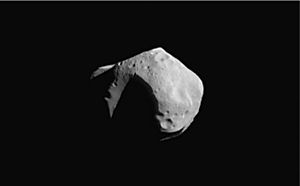C-type asteroid facts for kids

C-type asteroids are the most common type of asteroid in our solar system. The "C" stands for carbonaceous, which means they are rich in the element carbon. Imagine them as giant, dark space rocks. About 75% of all known asteroids are C-types!
These asteroids are made of carbon, rocks, and minerals. Because of the dark carbon, they have a very low albedo, which means they don't reflect much sunlight. This makes them very hard to see from Earth. They are also known to contain materials like water ice that can easily turn into gas.
Most C-type asteroids are found in the outer parts of the asteroid belt, a big ring of asteroids between Mars and Jupiter. They are about 3.5 au (520 million km; 330 million mi) away from the Sun. In this outer region, 8 out of every 10 asteroids are C-types. Because they are so dark, there might be even more C-type asteroids that we just haven't discovered yet.
Contents
What Are C-Type Asteroids Made Of?
The ingredients of C-type asteroids are very interesting to scientists. Their makeup is very similar to a type of meteorite called a carbonaceous chondrite. These meteorites are like time capsules from the beginning of our solar system. They have a chemical mix that is almost the same as the Sun, but without the light gases like hydrogen and helium.
A key feature of C-type asteroids is that they contain hydrated minerals. This is a scientific way of saying they have minerals with water locked inside them. This discovery suggests that water was present in the early solar system.
Because they contain lighter materials like ice, C-type asteroids are not very dense. On average, their density is about 1.7 g/cm3. This is less than twice the density of water.
The largest asteroid that is clearly a C-type is 10 Hygiea. However, some classification systems also include the largest asteroid of all, the dwarf planet Ceres, in this group.
How to Spot a C-Type Asteroid
C-type asteroids are extremely dark. Their albedo, or how much light they reflect, is usually between 0.03 and 0.10. This means they only reflect 3% to 10% of the sunlight that hits them. For comparison, fresh asphalt on a road reflects about 4% of light.
Because they are so dark, you can't see them with just binoculars, even when they are closest to Earth. You would need a small telescope to spot even the biggest C-type asteroids. The brightest C-type asteroid is 324 Bamberga, but its orbit is so stretched out that it only gets bright enough to see on rare occasions.
When scientists study the light from these asteroids, they see that the asteroids absorb a lot of ultraviolet light. This "water" absorption signal, seen in the light they reflect, is another clue that they contain water.
Grouping Carbon-Rich Asteroids
Scientists like to organize asteroids into groups based on what they are made of. The C-type asteroid is the main member of a larger family called the C-group. This group includes other carbon-rich asteroids that are slightly different.
Some of the other types in the C-group include:
- B-type: These are similar to C-types but are slightly more reflective and have a different color.
- F-type: Another variation similar to B-types.
- G-type: These are like C-types but show strong ultraviolet light absorption.
Different classification systems, like Tholen and SMASS, group these asteroids in slightly different ways. But they all agree that these asteroids share a common carbon-rich origin.
See also
 In Spanish: Asteroide de tipo C para niños
In Spanish: Asteroide de tipo C para niños

